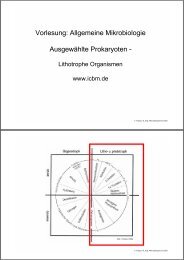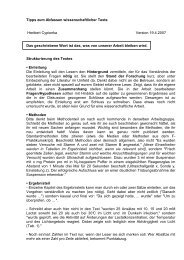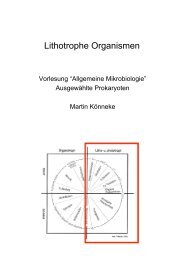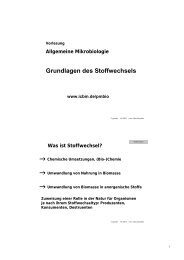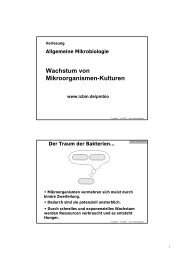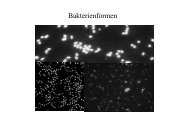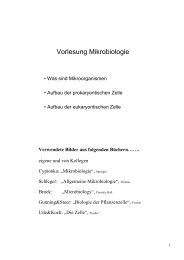You also want an ePaper? Increase the reach of your titles
YUMPU automatically turns print PDFs into web optimized ePapers that Google loves.
<strong>What</strong> <strong>are</strong> <strong>Sediments</strong>?<br />
Residues of<br />
algae and<br />
mussels<br />
Sulfur<br />
Diatoms<br />
(brown)<br />
Sand<br />
FeS<br />
WS 2009/10<br />
Practical course<br />
Feb 8-Mar 8<br />
5<br />
1
Recommended books<br />
- Brock. Biology of Microorganisms<br />
- Ehrlich H. L. (1996) Geomicrobiology, Marcel Dekker, New York<br />
- Richard Y. Morita (1997) Bacteria in Oligotrophic Environments, Chapman & Hall<br />
- L.A. Meyer-Reil, M. Köster (1993) Mikrobiologie des Meeresbodens. Fischer<br />
- Daniel M. Alongi (1998) Coastal Ecosystem Processes. CRC Press<br />
- Susan M. Libes (1992) An Introduction to marine biogeochemistry, John Wiley<br />
- Tom Fenchel and Bland J. Finlay (1995) Ecology and Evolution in Anoxic Worlds,<br />
Oxford University Press<br />
- Jame K. Fredrickson, Madilyn Fletcher (ed. 2001) Subsurface Microbiology and<br />
Biogeochemistry, Wiley<br />
- Amy P.S., Haldeman D.L (ed., 1997) The Microbiology of the Terrestrial Deep<br />
Subsurface, Lewis Publ. New York<br />
-Schulz HD, Zabel M (ed., 2000) Marine Geochemistry. Springer, Berlin<br />
Literature on the web<br />
- http://www.icbm.de/pmbio/litlinks.htm (many (<br />
journals!)<br />
- http://portal.isiknowledge.com (Web (<br />
of Science - from University IP)<br />
- http://scholar.google.com (Science (<br />
at Google)<br />
2
<strong>What</strong> <strong>are</strong> sediments?<br />
latin: sedere = sit sedimentum = what has settled down<br />
• Particulate material accumulated on the floor<br />
- of lakes (lacustrine, limnic)<br />
- of rivers (riverine, fluvial)<br />
- of the sea (marine, tidal, coastal...)<br />
Sedimentation rates in aquatic systems<br />
Which factors govern sediment formation rates?<br />
- Productivity (primary production)<br />
- Input of allochthoneous material (rivers, shore; e.g. leaves)<br />
- Settling time (depth, degradation while sedimentation)<br />
- Water chemistry (e.g. carbonates)<br />
Annual sedimentation rates [mm]<br />
Oligotrophic lakes<br />
Eutrophic lakes<br />
Marine upwelling <strong>are</strong>as<br />
Deep sea<br />
0.1 – 2<br />
1 – 5<br />
0.05 – 0.3<br />
0.001 – 0.02<br />
3
<strong>What</strong> is the origin of marine sedimentary material?<br />
- aeolian = via the air<br />
- terrigenous = from the land<br />
- marine, autochthonous = from water column<br />
Aeolian input to sediments<br />
Sahara sand coming across<br />
the alpes<br />
Sahara sand above the<br />
Atlantic Ocean<br />
• Input of minerals, especially Fe as an important limiting factor<br />
4
Ash eruptions from vulcanoes<br />
Ash layer in<br />
Mediterranean sediment<br />
Lena river delta (Sibiria)<br />
5
From the mountains to the sea and back<br />
Erosion and destruction<br />
- Night frost results in cracking of rocks<br />
- Rocks break during landslides<br />
- Destruction of destabilized minerals via dew formation and rainfall<br />
Night frost<br />
Rock<br />
fan<br />
Tarbuck & Lutgens:<br />
Allgemeine Geol ogie, mod.<br />
Rock<br />
fan<br />
6
From the mountains to the sea and back<br />
Erosion and destruction<br />
- Night frost results in cracking of rocks<br />
- Rocks break during landslides<br />
- Destruction of destabilized minerals via dew formation and rainfall<br />
Transport of fragments and single minerals<br />
- Water (creeks, rivers, ocean currents)<br />
- Wind<br />
- Ice (glaciers)<br />
Sedimentation<br />
= Accumulation and consolidation of weathering products<br />
- Formation of porous sediments<br />
- Overlay with further sediments lead to<br />
→ Enhanced temperatures and pressure<br />
- Squeezing of porewater from porous sediments<br />
- Consolidation and cementation by recristallisation to sedimentary rocks<br />
10 cm<br />
Tidal-flat sediment „Neuharlingersieler Nacken“<br />
20 cm<br />
30 cm<br />
40 cm<br />
50 cm<br />
60 cm<br />
70 cm<br />
80 cm<br />
90 cm<br />
Swartberg-Pass (South africa)<br />
100 cm<br />
7
Deformation of sedimentary rocks<br />
Deformation<br />
Laminated<br />
sediments<br />
Tarbuck & Lutgens:<br />
Allgemeine Geol ogie, mod.<br />
Swartberg-Pass (South africa)<br />
8
Disturbed sediment<br />
Mediterranean sediment<br />
disturbed by hang slip<br />
Disturbed sediment: Turbidites<br />
Submarine<br />
canyons<br />
Turbidite deposition<br />
Turbidite<br />
Turbidites<br />
Deep sea<br />
fans<br />
Graduated layers<br />
Tarbuck & Lutgens:<br />
Allgemeine Geol ogie, mod.<br />
9
Distribution of chlorophyll in the ocean<br />
How fast do sediments accumulate?<br />
Euphotic zone
Varves<br />
Sandy sediments<br />
North Sea<br />
tidal flat<br />
Puerto Rico<br />
11
Sediment-forming organisms<br />
Carbonates<br />
• biogic in sheats of algae (Coccolithophorides), Foraminifera, ...<br />
• precipiatated via enhanced temperature or photosynthesis<br />
Silikates<br />
• biogeic in sheats of Diatoms or Radiolarians<br />
• chemical as clay minerals via inflow<br />
Coccolithophorides Foraminifera Radiolarians Diatoms<br />
www.unibas .ch/z mb/ caliban.mpiz-koel n.mpg.<br />
www.unibas .ch/z mb/ www.reclot.de/bilddat/geolog/<br />
de/~stueber/haeckel/k unstformen/<br />
d44mik/mikro03.htm<br />
Tafel_002.html<br />
Coccolithophorids<br />
Cell size: 2-20 mm<br />
Cell wall: CaCO 3<br />
coccoliths or<br />
scales<br />
Chloroplasts: none, single<br />
thylakoid membrane<br />
Photo-pigments:<br />
chlorophyll a<br />
& c, carotenoids<br />
Reproduction: simple cell<br />
division, r<strong>are</strong>ly sexual<br />
reproduction<br />
Ecological roles: biflagellated,<br />
produce chalk deposits<br />
Common genus:<br />
Emiliania<br />
Emiliania huxleyi<br />
Botanical Bulletin of Academia Sinica,<br />
Vol. 42, 2001<br />
lat. coccus = round, gr. lithos = stone, gr. pherein = carry<br />
12
Foraminifera<br />
... a paleoclimate proxy?<br />
lat. foramen = hole, lat. ferre = carry<br />
Deutsch: Foraminiferen, Kammerlinge,<br />
Klasse der Rhizopoda (Wurzelfüßer)<br />
Foraminifera<br />
"Sand" at the Bight of Alcudia, Mallorca<br />
13
Diatoms (Kieselalgen)<br />
Pacific sediment (Peru margin)<br />
Pacific diatoms<br />
North Sea diatoms (tidal flat)<br />
Radiolarians (Strahlentierchen)<br />
From Haeckel:<br />
"Kunstformen der Natur"<br />
14
Oxygen isotope fractionation as proxy for the ocean water<br />
temperature<br />
-> Natural 18 O: 16 O ratio about 1:500<br />
determined in microfossils, that use oxygen for shell formation<br />
(benthic and planktonic foraminifers, coccolithophorids)<br />
-> Variation of delta 18 O values controlled by temperature:<br />
preferred evaporation of light H 2 16 O molecules<br />
comp<strong>are</strong>d to heavier H 2 18 O.<br />
-> Cold air carries relatively less H 2 18 O,<br />
which remains enriched in the water.<br />
-> 1% increase of delta 18 O corresponds to<br />
about 1 °C temperature decrease.<br />
Sediment Temperature<br />
-> Seafloor mostly around 0 - 2 °C<br />
-> Temperature increase with depth,<br />
depending on geological parameters<br />
-> Hydrothermal vents with temperatures<br />
above 300 °C<br />
15
How old <strong>are</strong> sediments?<br />
Only 200 Mio. years before<br />
present there was only one<br />
continent, Pangaea<br />
Online Biology Book<br />
Mike Farabee<br />
www.emc.maricopa.edu/faculty/far<br />
abee/BIOBK/BioBookTOC.html<br />
Plate tectonics<br />
16
Plate tectonics govern sediment age<br />
http://www.ngdc.noaa.gov<br />
Mid-oceanic ridges (spreading centers)<br />
• Form the longest mountain chain on earth<br />
Inorganic reduced compounds <strong>are</strong> released, e.g., 30 Mio t H 2<br />
S per year<br />
(Ocean water moves through the earth crust on average in 8 Mio a)<br />
• Hydrothermal vent production, 0.02 % of total primary production<br />
= 10 % of the sea-floor production<br />
• Rich communities based of bacterial chemosynthesis<br />
e.g. Riftia pachyptila: huge worm without mouth and after<br />
living from symbiotic autotrophic H 2<br />
S oxidizers<br />
• Energy from the oxidation of H 2<br />
S, H 2<br />
, Fe 2+ etc. with oxygen (from photosynthesis!)<br />
17
Life at Mid-oceanic ridges<br />
By which properties <strong>are</strong> sediments characterized?<br />
- TOC (total organic carbon): 0.2 - 2 %, sapropels up to 30 %<br />
- 50% carbonaceous <strong>Sediments</strong> (50 - 90 % TIC), less with silicates (Diatoms etc.)<br />
- Water: porosity and permeability decreasing with depth and age<br />
- Varying particle size: mud, silt 63 - 200 µm, sand > 63 µm,<br />
- Varying density: ~1.5 to ~2.5 g/cm 3<br />
- Oxygen: upper mm to meters<br />
- Nitrate: slightly below oxygen<br />
- Ammonia as a product of degradation<br />
- Fe 3+ , Mn 4+ -> Fe 2+ , Mn 2+ with increasing depth<br />
- Sulfides<br />
- Methane hydrates<br />
18
How can we detect processes inside the sediment column?<br />
Gradients!<br />
Janssand<br />
Neuharlingersieler Nacken<br />
19
Oxygen profile<br />
Seawater<br />
Diffusive boundary<br />
layer<br />
Oxygen<br />
Sandkorn<br />
Sediment<br />
20
Sulfate-methane interfaces<br />
ODP Site 1229<br />
- Methanogenesis and sulfate reduction as dominant terminal processes<br />
- Anaerobic methane oxidation as important process<br />
Methane-bearing<br />
deep-sea sediment<br />
1 bar pressure increase per 10 m<br />
water depth<br />
21
Methane hydrate<br />
(ODP Site 1230)<br />
The most important reservoir of<br />
reduced carbon on earth<br />
2407-2410<br />
2410<br />
Meteor Leg M40-4 (1998)<br />
Sapropel layers with up to 30 % organic carbon and<br />
increased microbial activity<br />
22
Swamps<br />
Biogenic sediments:<br />
From peat to coal<br />
Coverage<br />
Peat<br />
(plant material)<br />
Consolidation<br />
Enhanced<br />
Coverage<br />
Lignite<br />
(brown coal)<br />
Consolidation<br />
Metamorphosis<br />
Pitch coal<br />
(soft black coal)<br />
Tension<br />
Peat in the backbarrier tidal flat of<br />
Spiekeroog, a former moor<br />
Tarbuck & Lutgens:<br />
Allgemeine Geol ogie, mod.<br />
Anthracite<br />
(hard coal)<br />
Microbial mats<br />
Farbstreifen-Sandwatt<br />
Saltmarsh pond (South africa)<br />
23
Stromatolite<br />
(pillow stone)<br />
1.3 Ga<br />
Ga = Giga years or<br />
billion years<br />
Attention:<br />
Engl. Billion = german Milliarde<br />
Undisturbed<br />
development in the<br />
absence of grazers<br />
Shark Bay,<br />
Australia<br />
Banded Iron Formations (BIF's,<br />
gebänderte Eisensteine)<br />
without microfossils, but<br />
showing isotope fractionation<br />
of 12 C/ 13 C as indicator for<br />
biological activity<br />
Periodic changes between reducing and oxidizing conditions<br />
Oxidation of Fe 2+ to Fe 3+ by<br />
(oxygenic?) photosynthesis,<br />
Precipitation of oxidized iron salts<br />
Ditch, Oldenburg University<br />
24
Sediment slurries at ODP Site 1231<br />
Oxidized iron and manganese as important electron<br />
accptors in low-carbon sediments<br />
Age<br />
Productivity and external input<br />
Thickness<br />
25



